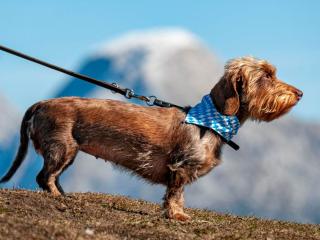

Teach your dog to walk well on a leash, you’ll be grateful for having taken the time for it.
According to World Health Organization, it’s recommended to take about 5 miles (8 kilometers) or 10,000 steps a day for good health. By walking your dog daily, you can easily reach this goal.
For this ritual to become a pleasant habit, it’s essential to teach your pooch leash walking. To say goodbye to lower back pain and tendonitis from a dog that keeps tugging you around, training is the solution!
We can’t stress this enough: Your companion should be conditioned from a very young age. Bad behavior is very hard to eliminate.
In short, you’re the only master on deck, and for the entire cruise!
Preparation:
Choose right gear:
 The harness is highly recommended as it distributes your animal’s weight and prevents him from getting choked by leash pressure on his collar. There are quite a few different designs. NON-PULL is ideal to start with as it’s easy to adjust on a growing individual. It naturally limits dog’s pulling. Two straps placed under front paws tense and make him walk at your pace. Don’t forget to remove it after each outing because a puppy chews on everything. Later on, you can find one that is a perfect fit to his body shape.
The harness is highly recommended as it distributes your animal’s weight and prevents him from getting choked by leash pressure on his collar. There are quite a few different designs. NON-PULL is ideal to start with as it’s easy to adjust on a growing individual. It naturally limits dog’s pulling. Two straps placed under front paws tense and make him walk at your pace. Don’t forget to remove it after each outing because a puppy chews on everything. Later on, you can find one that is a perfect fit to his body shape.How to train and practice:
After gearing up and choosing which side your puppy will walk on (usually on the right, it’ll stay the same for life), you can do a test run in your yard or a quiet place to observe his attitude. The leash should be slack. You may face three scenarios:
 Dog keeps pulling: If he gets ahead of you, say his name followed by a firm “No!” Give a slight jerk to the leash and order “heel!” so he retakes his position. If successful, make sure to praise him energetically.
Dog keeps pulling: If he gets ahead of you, say his name followed by a firm “No!” Give a slight jerk to the leash and order “heel!” so he retakes his position. If successful, make sure to praise him energetically.After mastering leash walking, bonding moments are guaranteed. Every family member will be happy to walk and do activities with this companion. Why not try cani-mountain biking or canicross?
For adult dogs whose leash training didn’t go as planned, you could try a head collar. The more they pull on the leash, the more the nylon strap wrapping their snout forces their head downwards because of pressure on their nasal bridge. This makes them walk at their master’s pace.
→ Food for thought:
“I decided to be happy because it’s good for health.” – Voltaire